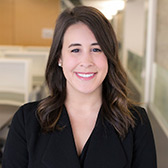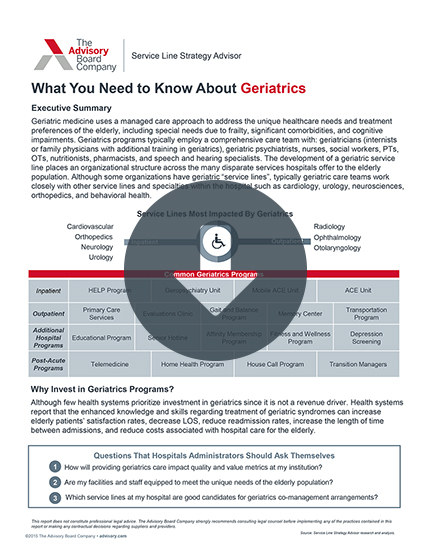Read Advisory Board's take: The two-fold benefit of a geriatric ED accreditation
More than 100 hospitals across the United States have established geriatric EDs to meet the unique health care needs of the growing elderly population, Beth Howard reports for the Wall Street Journal.
What older patients need
The number of older adults in the United States is increasing, which means the age of ED patients is rising, too. In fact, CDC data show ED visits by patients older than age 65 increased by more than one-quarter between 2005 and 2015.
And that older population of patients comes with unique health care needs, ones that EDs are not traditionally set up to treat, Kevin Biese, an emergency-medicine physician and head of the Geriatric ED Accreditation Board of the American College of Emergency Physicians, explained. Instead of presenting with ailments EDs were designed to treat—like heart attacks and gunshot wounds—seniors are more likely to seek treatment for fall injuries or complications from ailments like diabetes and heart failure, according to Biese.
In turn, there's "a growing awareness" about how EDs fall short in treating older patients, which has led dozens of hospitals around the country—including Holy Cross Hospital in Maryland, Aurora Health Care hospitals in Wisconsin, and St. Joseph's University Medical Center in New Jersey—to establish specially designed geriatric EDs.
Inside the new geriatric EDs
Mark Rosenberg, chair of emergency medicine at St. Joseph's University Medical Center, established one of the nation's first geriatric EDs in 2009. Today, more than 50 geriatric EDs have the Geriatric Emergency Department Accreditation (GEDA), and more than 100 are in the accreditation process, according to Biese.
Rosenberg decided to pursue the venture after watching his mother make a few unsuccessful trips to the ED for an aortic aneurysm. "Every time she would go there, she was afraid," Rosenberg said. "She was either near somebody who was a drug overdose, a stabbing victim or a crying child, and she hated it so much that sometimes she would even leave, against medical advice."
Rosenberg's goal when designing the 20-bed geriatric ED was to reduce patients' wait times to less than 14 minutes and to offer those patients a safe and comfortable environment in which to seek care. To that end, the unit offers patients thicker mattresses, as well as aromatherapy, books, and live harp music.
UC San Diego's geriatric ED, similarly, is equipped with sound-absorbing walls, a nonslip floor to prevent falls, and a lighting system that matches the time of day to prevent delirium in elderly patients." Vaishal Tolia, head of the unit, said that "the structural elements are meant for safety and to provide a soothing environment for [patients] and their families."
Along with specialized design, geriatric EDs also have multidisciplinary staff that are trained in geriatric care. At UC San Diego, geriatric nurses are trained to screen for elder abuse, fall risk, depression, and cognitive impairment in patients, Howard reports. If any of the issues are identified, the nurses can consult with other specially trained staff like case managers, social workers, nutritionists, physical therapists, pharmacists, and palliative-care specialists.
And unlike traditional EDs, the specialized care doesn't stop at the site of care. Some geriatric EDs will send social workers to the patient's home to check for trip hazards, while ED physicians might prescribe a patient with a visiting-nurse service that allows the patient to receive antibiotics at home. According to a 2018 study in the Journal of the American Geriatric Society, these practices can prevent 16% of unnecessary hospital admissions by seniors.
One main goal of the specialized care is to prevent geriatric patients from being admitted to the hospital where Howard reports they're at increased risk of infection and falls that can "have detrimental long-term effects."
Denise Nassasi, director of the geriatric ED at Mount Sinai, said, "Older patients tend to not bounce back as well if they're admitted to the hospital the way a younger person would have." Instead, older patients "will often lose one of their activities of daily living, perhaps irreversibly."
Elderly patients embrace the new EDs
According to Howard, patients are noticing a difference as well. Marcus Overton, a 75-year-old former actor and arts administrator who has diabetes and heart-valve problems, said he used to hate EDs. "They're chaotic and loud," he said. "They usually put you in a bed, pull a curtain around you, and you wait."
But Overton embraced the geriatric ED at UC San Diego. "It's quiet. You're in a room where you can look at a beautiful mural and doze in between visits from the folks who are trying to find out what is wrong with you," he said (Howard, Wall Street Journal, 4/21).
Advisory Board's take

Taylor Hurst, Consultant, Physician Executive Council
Given the rising volume of ED visits by geriatric patients, it's increasingly important to improve emergency care for the elderly population. As we've been conducting our latest research on how to deliver a quality-driven patient experience, we've spent time speaking with early movers in this space. The resounding takeaway: health systems can't simply retrofit traditional EDs to meet geriatric patients' needs. Rather, providers need a tailored solution that meets these patients where they are—whether that's checking their dentures during an inpatient stay, or identifying fall hazards in the home.
“Health systems can't simply retrofit traditional EDs to meet geriatric patients' needs.”
That's where the Geriatric Emergency Department (GED) comes in. The concept has been around for years, but only last year did the American College of Emergency Physicians launch a formal accreditation, which standardized criteria for what a best-in-class GED looks like. The criteria outlines staffing requirements, recommended screenings, and physical space modifications to provide health systems a clear roadmap for how to bolster care for geriatric ED patients. To underscore just how much momentum there is behind the accreditation, in just under a year since its launch, there's already a 3-4 month waiting period for interested organizations.
We expect the benefits of this accreditation to be two-fold. First and foremost: it should help guarantee that geriatric patients and their families receive consistent quality and experience across sites. In fact, early movers in this space have found the GED to be one of those rare win-win strategies that simultaneously improves patient satisfaction and key quality outcomes, such as readmissions. Second, the GED accreditation gives health systems another lever to differentiate themselves in their market. Currently, there are an estimated 130 self-proclaimed GEDs across the country—accreditation should raise the bar and help best-in-class programs stand out. Interested in learning more? Check out the Geriatric Emergency Department Accreditation website.
Then, be sure to read our colleague's blog post outlining three steps your geriatric ED should follow to address often-overlooked senior patient care gaps, and download our primer on how to Address Avoidable ED Utilization for Geriatric Patients.
Don't miss out on the latest Advisory Board insights
Create your free account to access 2 resources each month, including the latest research and webinars.
Want access without creating an account?
You have 2 free members-only resources remaining this month remaining this month.
1 free members-only resources remaining this month
1 free members-only resources remaining this month
You've reached your limit of free monthly insights
Become a member to access all of Advisory Board's resources, events, and experts
Never miss out on the latest innovative health care content tailored to you.
Benefits include:
You've reached your limit of free monthly insights


